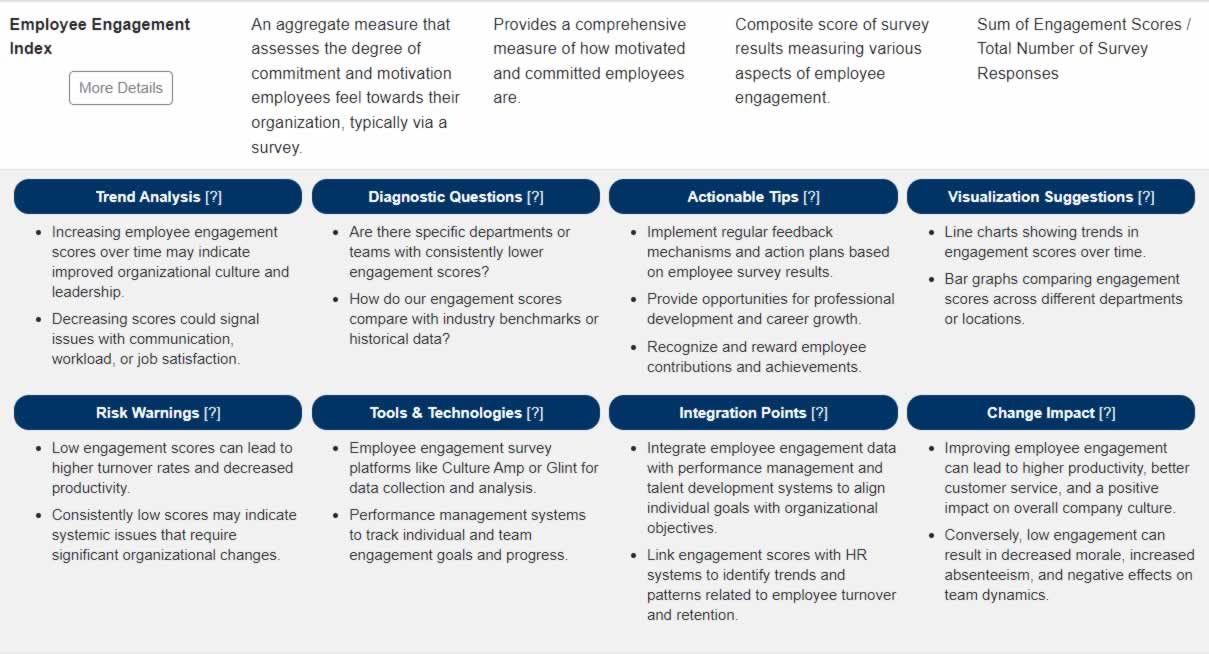Editor's Note: Take a look at our featured best practice, Cost Segregation Study: Multiple Property Class Analysis (Excel workbook). Accountants, accounting firms, and real estate property owners can all benefit from this cost segregation study (CSS) template. It makes the estimated benefit easy to figure out and has flexible assumptions for high level or detailed segregation analysis. You get a summary of cost [read more]
KPI Management: Employee Engagement KPIs
* * * *

The concept of Employee Engagement encompasses strategies and practices aimed at creating a work environment that fosters employee commitment, motivation, and satisfaction. In the broader context of strategic planning and performance measurement, understanding and enhancing employee engagement is essential for achieving competitive advantage, operational excellence, and sustainable growth.
This article aims to explore the critical role of Employee Engagement within organizations, focusing on how Key Performance Indicators (KPIs) associated with this area can facilitate informed decision-making, strategy formulation, and operational improvements. By delving into these KPIs, we seek to provide executives and senior managers with actionable insights into measuring and improving the level of engagement among their workforce, thereby driving organizational performance and employee well-being.
Importance of Employee Engagement
Employee Engagement is vital for any organization looking to excel in today’s dynamic and competitive business environment. Studies have consistently shown that engaged employees are more likely to exceed performance expectations, contributing to higher levels of organizational productivity, innovation, and customer satisfaction.
Furthermore, in the era of the Great Resignation and shifting workplace dynamics, the ability to attract, engage, and retain top talent has become more crucial than ever. Organizations that prioritize employee engagement are better positioned to adapt to change, overcome challenges, and capitalize on new opportunities.
Challenges to Fostering a Culture of Employee Engagement
Organizations face numerous challenges in fostering a culture of engagement, including aligning employee goals with organizational objectives, ensuring effective communication, recognizing and rewarding employee contributions, and providing opportunities for growth and development. Additionally, the rise of remote and hybrid work models has introduced new complexities in maintaining connection and engagement among dispersed teams.
KPIs related to Employee Engagement help address these challenges by offering a framework for systematically measuring the effectiveness of engagement initiatives, identifying areas for improvement, and tracking progress over time. Through a strategic focus on enhancing employee engagement, organizations can overcome obstacles to employee satisfaction and loyalty, ultimately driving superior business outcomes.
Top 10 Employee Engagement KPIs
Bolstering employee engagement is pivotal for organizational success. Here are the top 10 KPIs essential for measuring and improving Employee Engagement. These KPIs are selected from the Flevy KPI Library, a robust database of over 15,000+ KPIs.
1. Employee Engagement Index
- Definition: A composite metric that measures employees’ emotional investment, commitment, and satisfaction with their jobs.
- Relevance: Central to understanding the overall health of employee engagement within the organization, guiding targeted improvement actions.
2. Employee Net Promoter Score (eNPS)
- Definition: Measures the likelihood of employees recommending their workplace to friends or family, reflecting their overall satisfaction and loyalty.
- Relevance: A high eNPS is indicative of a positive work environment, which can attract top talent and reduce turnover rates.
3. Absenteeism Rate
- Definition: The rate at which employees are absent from work, excluding planned leaves of absence.
- Relevance: Chronic absenteeism can signal low engagement levels, workplace dissatisfaction, or health issues, impacting productivity.
4. Turnover Rate
- Definition: The percentage of employees who leave the company within a specific period, voluntarily or involuntarily.
- Relevance: A high turnover rate may indicate underlying issues with engagement, culture, or job satisfaction.
5. Employee Satisfaction Rating
- Definition: A measure of how satisfied employees are with their job, work environment, and organizational policies.
- Relevance: Directly impacts employee retention, productivity, and the ability to attract new talent.
6. Leadership Trust Level
- Definition: Employees’ confidence in organizational leadership and their belief that leaders act in the employees’ and the company’s best interests.
- Relevance: Trust in leadership is a cornerstone of employee engagement, influencing morale and organizational commitment.
7. Employee Recognition Index
- Definition: The frequency and quality of acknowledgment employees receive for their contributions and achievements.
- Relevance: Recognition is a powerful motivator, enhancing employee satisfaction and reinforcing desired behaviors.
8. Work-Life Balance Satisfaction
- Definition: Employees’ contentment with their ability to balance professional responsibilities with personal life.
- Relevance: Satisfactory work-life balance is critical for preventing burnout and fostering long-term engagement.
9. Career Path Ratio
- Definition: The availability and clarity of career advancement opportunities within the organization.
- Relevance: Clear career paths contribute to higher engagement by aligning employee growth aspirations with organizational goals.
10. Feedback Responsiveness
- Definition: The extent to which management listens to and acts upon employee feedback.
- Relevance: Responsiveness to feedback demonstrates that an organization values its employees’ input, fostering a culture of trust and continuous improvement.
To dig deeper into any of these KPIs, we invite you to explore the Flevy KPI Library, which allows you to drill down into 12 attributes for each KPI in the database. Here is an example for our top ranked KPI, Employee Engagement Index:
Case Studies and Success Stories
Boosting Engagement with a Comprehensive Recognition Program
A technology firm noticed a decline in its Employee Satisfaction Rating and sought to reverse this trend by enhancing its “Employee Recognition Index.” The leadership team recognized the need for a more robust recognition program to boost morale and engagement.
The company overhauled its recognition program, introducing peer-to-peer recognition, monthly awards for outstanding achievements, and annual awards for exceptional contributions. Each recognition was linked to specific behaviors and achievements that aligned with the company’s values and objectives.
Outcome: Following the implementation of the new recognition program, the company saw a significant improvement in its Employee Recognition Index. This uplift was accompanied by a notable increase in the Employee Satisfaction Rating and a decrease in the Turnover Rate, indicating higher levels of overall employee engagement and loyalty.
Lessons Learned: Effective recognition programs that align with company values and are visible to the entire organization can significantly enhance employee engagement. Personalized and meaningful recognition contributes to a positive work culture, encouraging employees to perform at their best.
Implementing Flexible Work Arrangements for Work-Life Balance
A consumer goods company faced challenges with employee burnout and low “Work-Life Balance Satisfaction” scores. The HR team identified the need for flexible work arrangements to address these issues.
The company introduced flexible working hours and the option for remote work, where feasible. It also launched workshops on time management and provided resources to support employees in balancing their professional and personal responsibilities.
Outcome: The introduction of flexible work arrangements led to a marked improvement in Work-Life Balance Satisfaction. This change also positively impacted the “Leadership Trust Level,” as employees felt supported by the company’s commitment to their well-being. Additionally, the “Employee Satisfaction Rating” increased, reflecting greater overall contentment with the workplace environment.
Lessons Learned: Flexibility in work arrangements can significantly improve employees’ ability to manage work-life demands, leading to higher engagement and satisfaction levels. Demonstrating trust and support for employees’ well-being strengthens loyalty and commitment to the organization.
Additional Resources and Further Reading
Foremost, if you are in the process of selecting or refreshing your Human Resource Management KPIs, take a look at the Flevy KPI Library. With over 15,000+ KPIs, our KPI Library is one of the largest databases available. Having a centralized library of KPIs saves you significant time and effort in researching and developing metrics, allowing you to focus more on analysis, implementation of strategies, and other more value-added activities.
Here are other KPI Strategy and KPI Management articles we’ve published:
- Principles of KPI Selection. This article breaks down the 8 guiding principles to KPI selection and provides several case studies on how to use these principles in practice.
- Principles of KPI Maintenance. It’s important to recognize that as market conditions and strategic objectives evolve, so too must the KPIs. This article provides a disciplined approach to maintaining KPIs.
- KPI Dashboard Design & Visualization. Learn the art and science of designing KPI dashboards, including types of data visualization and how to choose among them.
- Anatomy of a Strong KPI. Learn what makes a KPI effective, discussing the characteristics of KPIs that are most impactful and how they can drive strategic business decisions.
- 10 Common Pitfalls in KPI Implementation. Learn how to identify and remediate the 10 most common pitfalls in KPI implementation. If left unfixed or as unknowns, these pitfalls can have disastrous, long-term impacts on the organization.
- KPIs and Organizational Alignment . This article discusses the concepts of strategic, tactical, and operational KPIs; as well as balancing individual, team, and organizational objectives.
- Integrating KPIs into Employee Performance. This article discusses 5 methods for integrating KPIs into individual performance metrics; and includes several case studies.
- Integrating KPIs into the Organizational Culture. This article breaks down 4 strategies for embedding KPIs into the Corporate Culture; also includes several case studies.
- Future-Proofing KPIs. Understand how to “future-proof” KPIs by understanding the impacts of emerging market trends, emerging technologies, and evolving consumer behaviors on KPIs.
- KPIs and Digital Transformation. All organizations are undergoing Digital Transformations. Learn how to define, select, and implement relevant Digital Transformation KPIs.

Do You Want to Implement Business Best Practices?
You can download in-depth presentations on 100s of management topics from the FlevyPro Library. FlevyPro is trusted and utilized by 1000s of management consultants and corporate executives.
For even more best practices available on Flevy, have a look at our top 100 lists:
- Top 100 in Strategy & Transformation
- Top 100 in Digital Transformation
- Top 100 in Operational Excellence
- Top 100 in Organization & Change
- Top 100 Management Consulting Frameworks
These best practices are of the same as those leveraged by top-tier management consulting firms, like McKinsey, BCG, Bain, and Accenture. Improve the growth and efficiency of your organization by utilizing these best practice frameworks, templates, and tools. Most were developed by seasoned executives and consultants with over 20+ years of experience.
Readers of This Article Are Interested in These Resources

|
|
145-slide PowerPoint presentation
|
|
Excel workbook
| |||
About Flevy Management Insights
Top 10 Recommended Documents














